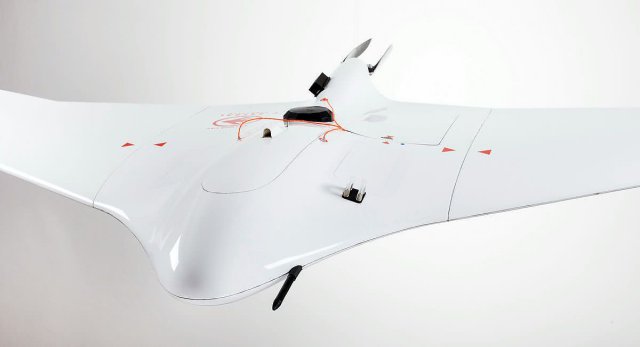
C-ASTRAL Aerospace has launched the new Bramor ppX long endurance small UAS in the US market, together with the ppX-LRS (Long Range Solar) version, developed in conjunction with the Sunnyvale, CA, thin film solar cells leader Alta Devices.
The ppX UAS builds upon a decade of operational experience in 80 countries with more than 50000 global flight hours. The all composite blended wing body system is an order of magnitude more capable than the competition, flying for 3.5 hours in the normal and up to 5.5 hours in the enhanced endurance LRS solar power assisted version and can carry an array of different advanced sensors for remote sensing, aero photogrammetry, surveying, agricultural mapping as well as classical intelligence, surveillance and reconnaissance missions.
The new ppX is complemented with a C3P (Command Control Communications and Planning) software package for mission planning and flight control, enabling a new level of situational awareness and intuitive systems control as well as with an online fleet management and maintenance support system, which will also enable current users and operators to share technical data as well as mission profile and performance parameters advice.
The so called “commercial drone revolution” is here and C-ASTRAL has been one of the companies that helped co-create it since 2007 from the tiny nation of Slovenia, which is, on the other hand, a definite technological and aerospace niche powerhouse, with companies such as Pipistrel, Dewesoft and C-ASTRAL being some of the global leaders in their respective fields.
The C-ASTRAL ppX UAS can fulfill an array of different missions, from surveying and remote sensing, infrastructure control, precision agriculture, flood monitoring, open pit mining, ecological monitoring and sensing, wildfire management and mitigation, classical ISR, civil defense, IED detection and fire control.
The array of sensors available for the system range from classical visible light to multispectral, hyperspectral as well as advanced gas laser sensors, capable of detecting 0.05ppm of methane gas in the air above the areas of interest where leaks could develop.
C-ASTRAL systems are used widely in research and development as well as environmental monitoring and compliance projects, ranging from the Arctic to Antarctica and have been flown in missions up to 14000 ft altitude.
“The modularity and flexibility of the sensor packages on our UAS is unrivaled in this weight class, and we are working very hard towards constant optimization. Every micro-ounce counts, every electronic element that needs to be powered too. We simply engineer for enduring precision,” said Nejc Trost, one of C-ASTRAL co-founders.
The C-ASTRAL ppX UAS system is also much more capable than the current US regulations allow, being able to fly so called beyond visual line of sight (BVLOS) corridor and pipeline monitoring missions at distances of up to 100 nautical miles, carrying an ADS-B mode S transponder. As such it will be ready for the future regulations, that will eventually enable long endurance and long distance BVLOS operations. C-ASTRAL’s customers have up to now realized missions that go far beyond what lesser systems with smaller endurance can accomplish. Among many others, they have surveyed 250 and 300 miles long railway corridors in record amount of time inEthiopia and Mozambique as well mapped large protected rainforest areas in Panama in support of indigenous land claims and mapped the whole nation of Cabo Verde.
Because of their carrying, endurance and performance capabilities, C-ASTRAL systems have been chosen in the USA and Europe for trials and research in UTM (unmanned traffic management) solutions and the company is also establishing a stateside support and distribution network to support growing and expanding US and Canadian markets.
Source: Press Release
